(完整版)夏威夷中英文简介
- 格式:doc
- 大小:27.02 KB
- 文档页数:1

(完整版)Hawaii夏威夷英⽂介绍HawaiiUnited States GeographyThe Hawaiian archipelago is a string of islands and reefs, 3,300 kilometers long, that forms a broad arc in the mid-Pacific. The archipelago begins in the east with the island of Hawaii and ends almost at the international date line with a small speck in the ocean called Kure Atoll. Only the easternmost 650 kilometers of the state contains islands of any size, as well as almost all of the state's population. It is this portion that is usually considered as the actual "Hawaii."The eight main islands of Hawaii--Oahu, Hawaii, Maui, Kauai, Lanai, Molokai, Niihau, and Kahoolawe--contain more than 99 percent of the state's land area and all but a handful of its people. The island of Hawaii, at 8,150 square kilometers, comprises nearly two-thirds of the state's total area, and it is often referred to as simply the Big Island. The smallest of the eight, Kahoolawe, is 125 square kilometers and is uninhabited.LOCATION AND PHYSICAL SETTINGHawaii is near the middle of the Pacific Ocean. Honolulu, the state capital,is 3,850 kilometers west of San Francisco, California, 6,500 kilometers east of Tokyo, Japan, and roughly 7,300 kilometers northeast of the Australian coast. This might be viewed as a case of extreme isolation, and until the last few centuries this was probably true. But as countries around the Pacific Basin began to communicate more with one another and to use the ocean's resources, these islands became an important center of interaction.The Hawaiian chain is merely the visible portion of a series of massive volcanoes. The ocean floor in this area is 4,000 to 5,000 meters below sea level. Hence, for a volcano to break the water's surface requires a mountain already approaching 5 kilometers in height.The kind of volcanic activity that created the islands and that continues there today has, for the most part, not been of the explosive type in which large pieces of material are thrown great distances. Volcanic cones resulting from explosive eruptions do exist on the islands. Diamond Head, the Honolulu landmark, is the largest at about 240 meters. More common, however, are features formed from a gradual buildup of material as a sequence of lava flows piled one layer on top of another. The usual shape of volcanic mountains formed in this way is domelike, with the main feature being undulating slopes instead of steep cliffs.Several of the volcanos on the Big Island remain active. Mauna Loa pours out lava on the average of once every four years, and volcanic activity poses a constant threat to Hilo, the island's largest town. A 1950 eruption covered some 100 square kilometers. Another volcano, Kiluea, is usually active, but lava actually flows from it about once in every seven years. A 1960 flow from Kiluea covered 10 square kilometers, adding some 260 hectares to the island's size.Hawaii is a state of rugged slopes and abrupt changes in elevation. This is the result of the erosion of the volcanic surfaces by moving water. Sea cliffs cut by waves form a spectacular edge to parts of the islands. Such cliffs on the northeast side of Molokai stand as much as 1,150 meters above the water and are among the world's highest; others on Kauai exceed 600 meters. Some small streams on the northeast side of the Big Island drop over such cliffs directly into the sea.Stream erosion has heavily dissected many of the lava surfaces. Canyons lace many of the domes. The floor of Waimea Canyon, on Kauai, is more than 800 meters below the surface of the surrounding land. Waterfalls several hundred meters high are common on the islands. The Pali, on Oahu, is a line of cliffs where the headwaters of streams eroding from opposite sides of the island meet. Those flowing east have eroded the ridges separating them to cut a broad lowland;the westward-facing valleys are higher and remain separated by ridges.One important result of this intense erosive action is a limited amount of level land on the islands. Kauai is particularly rugged, with the only lowlands formed as a thin coastal fringe. Maui has a flat, narrow central portion separating mountainous extremities. Molokai is reasonably flat on its western end. Oahu has a broad central valley plus some sizable coastal lowlands. The island of Hawaii has only some limited coastal lava plains.Hawaii's oceanic location obviously has a substantial impact on its climate. It is the ocean that fills the winds with the water that brush the islands' mountains. The ocean also moderates the islands' temperatureextremes--Honolulu's record high of 31癈 is matched by a record low of only 13癈.The latitude of Honolulu, about 20癗, is the same as Calcutta and Mexico City. As a result, there is little change in the length of daylight or the angle of incidence of the sun's rays from one season to another. This factor, plus the state's maritime position, means that there is little seasonal variation in temperature.It is variations in precipitation that mark the major changes in season on the islands. During the summer, Hawaii is under the persistent influence of northeast trade winds, which approach the islands over cool waters located to the northeast and create characteristic Hawaiian weather--breezy, sunny with some clouds, warm but not hot. In winter, these trade winds disappear, sometimes for weeks, allowing "invasions" of storms from the north and northwest. Honolulu has received as much as 43 centimeters of rain in a single 24-hour period. Hawaiian weather stations have also recorded 28 centimeters in an hour and 100 centimeters in a day, both of which rank near world records.The topography of the islands creates extreme variations in precipitation from one location to another. Mount Waialeale, on Kauai, receives 1,234 centimeters annually, making it one of the world's wettest spots, and Waimea, also on Kauai, receives about 50 centimeters annually--yet these two sites are only 25 kilometers apart. Within the metropolitan area of Honolulu, it is possible to live near the beach in a semiarid climate with less than 50 centimeters of rainfall annually or inland near Pali on the margins of a rain forest drenched by 300 centimeters of precipitation a year. Unlike the Pacific Northwest, the greatest precipitation on the higher mountains in Hawaii occurs at fairly low elevations, usually between 600 and 1,200 meters. Much of the volcanic soil is permeable. This allows water to percolate rapidly, draining beyond the reach of many plants. Thus, many areas of moderate to lowprecipitation are arid in appearance.The isolation of the Hawaiian islands, coupled with their generally temperate climate and great environmental variation, has created a plant and bird community of vast diversity. There are several thousand plants native there and found naturally nowhere else; 66 uniquely Hawaiian land birds have also been identified. Interestingly, there were no land mammals on the islands until humans arrived.POPULATING THE ISLANDSThe Polynesian settlement of Hawaii was a segment in one of humankind's most audacious periods of ocean voyaging. These people set out on repeated voyages in open canoes across broad oceanic expanses separating small island clusters. Settlers who came to Hawaii 1,000 years ago, for example, are presumed to have come from the Marquesas, 4,000 kilometers to the southwest. There was some kind of pre-Polynesian population on the island, but it was probably absorbed by the newcomers. A second substantial wave of Polynesian migrants arrived 500 or 600 years ago.The massive effort required by these voyages apparently became too great. As a result, Hawaii spent several hundred years in isolation after the second migration period. During the isolation, the Hawaiians solidified a complicated social organization in their insular paradise. Hereditary rulers held absolute sway over their populations and owned all of the land. By the late 18th century, when Europeans found the islands, the benign environment supported a population that numbered about 300,000.The first European to visit Hawaii, which he dubbed the Sandwich Islands, was Captain James Cook in 1778. Cook was killed on the shore of the Big Island, but news of his discovery spread rapidly after reaching Europe and North America; it was quickly recognized that the islands were the best location for a waystation to exploit the trade developing between North America and Asia.In the 1820s, the whaling industry moved into the North Pacific and, for the next half-century, the islands became the principal rest and resupply center for whalers. About the same time, Protestant missionaries came to the islands. Like most of the whalers, they were from the northeastern United States. They were very successful in their missionary work, and for decades had a major influence on the islanders.The first Hawaiian sugar plantation was established in 1837, although the islands did not become a substantial producer until after the middle of the century. Between then and the end of the 19th century, Hawaii grew to the rankof a major world sugar exporter.This development led to a need for agricultural laborers. Native Hawaiians were used for a time, but their declining numbers provided nothing like the labor force needed. Thus, between 1852 and 1930, plantation owners brought 400,000 agricultural laborers, mostly Asian, to Hawaii. In 1852, ethnic Hawaiians represented over 95 percent of the population of the islands. By 1900, they were less than 15 percent of the total population of just over 150,000, whereas nearly 75 percent were Oriental. After 1930, the mainland United States became the main source of new residents in Hawaii. In 1910, only about one resident of Hawaii in five was of European ancestry (referred to in Hawaii as Caucasian). Now, nearly 40 percent of the state's population is Caucasian or part-Caucasian.The population of Hawaii fell from its pre-European peak to a low of 54,000 in 1876 before beginning to grow again. By the early 1920s, the state's population had reached pre-European levels, and in 1988, the state had 1.1 million residents. Because of immigration, Hawaii's annual rate of population growth is well above the U.S. average.The pre-European population was spread across the islands, with the Big Island occupied by the largest number of people. Since European discovery, the islands' population has been concentrated increasingly on Oahu. Honolulu, with its fine harbor, became the principal port city.The political history of Hawaii was turbulent during the 120 years after Cook's discovery. The various kingdoms of the islands were eliminated by a strong chief, Kamehameha, between 1785 and 1795. The missionaries' growing influence gradually made a sham of the authority of the Hawaiian rulers, and, during the 19th century, competing European political interests moved in to fill the resulting vacuum.But the increasing role of Americans made it inevitable that, if Hawaii was to lose its political independence, it would be annexed by the United States. As American plantation owners increased in number and influence, their dissatisfaction with the Hawaiian government grew. In 1887, they forced the monarchy to accept an elected government controlled by the planters. The monarchy was overthrown completely in 1893, and the new revolutionary government immediately requested annexation by the United States. Initially refused, they were finally accepted as a territory in 1898.No provision was made at the time of annexation for the eventual admission of Hawaii to statehood, and it was not until 1959, after Alaska was admittedto the union, that Hawaii became the 50th U.S. state.THE HAWAIIAN ECONOMYRoughly half of all land in Hawaii is government owned, with the state, not the federal government, controlling 80 percent of that land. Most of it is in the agriculturally less desirable portions of the islands, and the bulk is in forest reserves and conservation districts. Most federal lands are primarily in national parks on the Big Island and Maui, or in military holdings on Oahu and Kahoolawe.Seven-eighths of all privately owned land in Hawaii is in the hands of only 39 owners; each owns 2,000 hectares or more. Six different landowners each control more than 40,000 hectares out of a state total of about 1,040,000 hectares. Smaller unit ownership of private land is most extensive on Oahu, but even there the larger owners control more than two-thirds of all privately owned land. Two of the islands, Lanai and Niihau, are each nearly entirely controlled by a single owner, and on all of the other islands (except Oahu) major landowners control about 90 percent of all privately held property.Most of these large landholdings were created during the 19th century period of freewheeling exploitation on the islands. Land had previously been held entirely by the monarchies. This land passed into the hands of non-Hawaiian private owners during the political decline of the monarchy. With the deaths of the early owners, most estates have been given over to trusts to administer rather than passing directly to heirs. This has made it difficult to break up the ownership patterns, which has led to high land values and pockets of high population density.Sugar, and later pineapples, fueled the Hawaiian economy for many decades after the 1860s. The economy remained primarily agricultural until the late 1940s. In recent decades, agriculture has continued to show modest gains in income, but its relative importance has declined. Only one Hawaiian worker in 30 is currently employed in agriculture.However, Hawaii continues to provide a substantial share of the world's sugar harvest, and its production of pineapples is about 650,000 tons annually, making it the world's largest supplier of pineapples.Gross economic statistics overwhelmingly emphasize the position of Oahu, where more than 80 percent of the state's economy is concentrated. The role of agriculture remains great on the other islands. Both Lanai and Molokai depend on pineapples for much of their employment and income. Livestock and sugar form the backbone of the economy on the Big Island, as do sugar andpineapples on Maui and Kauai.As agriculture declined and lost its dominance over the Hawaiian economy, its place was first taken by the federal government. Over the past several decades, governmental expenditures have increased at a rate roughly comparable to the growth of the total economy, maintaining about a one-third share of all expenditures. Most of this has come from the military, which controls almost 25 percent of Oahu, including the land around Pearl Harbor, one of the finest natural harbors in the Pacific. Nearly one Hawaiian worker in four is an employee of the military, and military personnel and their dependents together represent over 10 percent of Hawaii's population. The armed forces are also the largest civilian employer in the state.Tourism is a major industry, with over 4.5 million people visiting the state each year. Tourism has become the principal growth sector of the economy, increasing its share of total island income from 4 percent in 1950 to over 30 percent today. INTER-ISLAND DIVERSITYThe major Hawaiian islands are part of the same state, they have similar geologic histories, and they are closely spaced in a vast ocean, yet each has its own character. Oahu is densely populated and intensely used, and it offers a view of bustle and confusion common to urban America. The island of Hawaii, the Big Island, by comparison has an air of relative space and distance, with large ranches, high, barren volcanos, and large stretches of almost treeless land. Its land area is dominated by five huge shield volcanoes. Sugar, cattle ranching, and tourism are its major industries.Kauai, sometimes called the garden isle because of its lush tropical vegetation, is heavily eroded into a spectacular scenery of mountains, canyons, cliffs, and waterfalls. Kauai is becoming increasingly popular with tourists because of its dramatic physical environment. Neighboring Niihau is privately owned and is operated as the Niihau Ranch Company. Most of its few hundred residents are native Hawaiians.Maui, the second largest of the islands, offers a contrast between the plantations of its central lowlands and the rugged mountains to either side. Tourist development, concentrated along the western coastal strip, has been intense, with the result that Maui had the most rapid rate of population increase of any of the islands in the 1970s and 1980s. Still, much of the rest of the island remains little changed and sparsely populated.Molokai is half ranchland and half rugged mountains. Its north coast is dominated by spectacular sea cliffs as much as 1,100 meters high, while thesouth shore is a broad coastal plain. It is perhaps the least economically developed of the populated Hawaiian Islands. Lanai and Kahoolawe are both in the lea of much higher Maui. As a result, both are dry. Neither have any permanent streams. Pineapple production is the only important economic activity on Lanai. The U.S. Navy administers Kahoolawe and uses it for military exercises.。
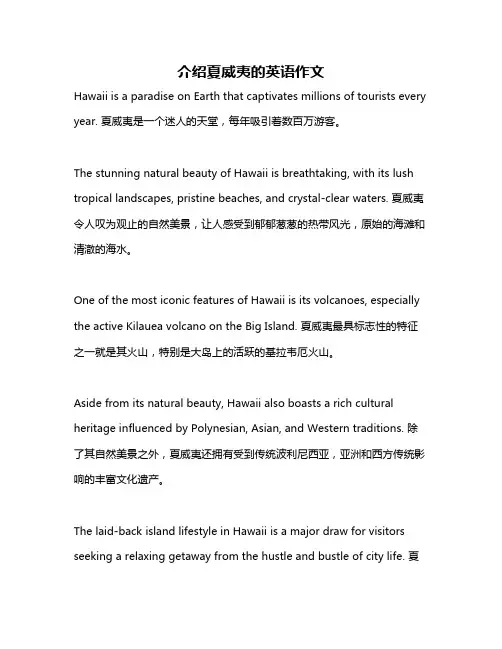
介绍夏威夷的英语作文Hawaii is a paradise on Earth that captivates millions of tourists every year. 夏威夷是一个迷人的天堂,每年吸引着数百万游客。
The stunning natural beauty of Hawaii is breathtaking, with its lush tropical landscapes, pristine beaches, and crystal-clear waters. 夏威夷令人叹为观止的自然美景,让人感受到郁郁葱葱的热带风光,原始的海滩和清澈的海水。
One of the most iconic features of Hawaii is its volcanoes, especially the active Kilauea volcano on the Big Island. 夏威夷最具标志性的特征之一就是其火山,特别是大岛上的活跃的基拉韦厄火山。
Aside from its natural beauty, Hawaii also boasts a rich cultural heritage influenced by Polynesian, Asian, and Western traditions. 除了其自然美景之外,夏威夷还拥有受到传统波利尼西亚,亚洲和西方传统影响的丰富文化遗产。
The laid-back island lifestyle in Hawaii is a major draw for visitors seeking a relaxing getaway from the hustle and bustle of city life. 夏威夷的悠闲岛屿生活方式吸引了寻求远离城市生活喧嚣的游客,让他们享受轻松的度假。
The diverse cuisine in Hawaii reflects its multicultural influences, offering a variety of delicious dishes blending flavors from different cultures. 夏威夷多元化的美食反映了其多元文化的影响,提供了品种繁多的美味佳肴,融合了不同文化的口味。

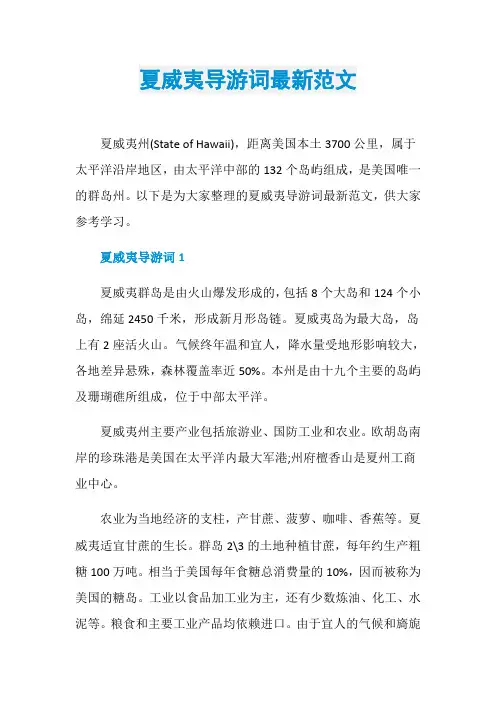
夏威夷导游词最新范文夏威夷州(State of Hawaii),距离美国本土3700公里,属于太平洋沿岸地区,由太平洋中部的132个岛屿组成,是美国唯一的群岛州。
以下是为大家整理的夏威夷导游词最新范文,供大家参考学习。
夏威夷导游词1夏威夷群岛是由火山爆发形成的,包括8个大岛和124个小岛,绵延2450千米,形成新月形岛链。
夏威夷岛为最大岛,岛上有2座活火山。
气候终年温和宜人,降水量受地形影响较大,各地差异悬殊,森林覆盖率近50%。
本州是由十九个主要的岛屿及珊瑚礁所组成,位于中部太平洋。
夏威夷州主要产业包括旅游业、国防工业和农业。
欧胡岛南岸的珍珠港是美国在太平洋内最大军港;州府檀香山是夏州工商业中心。
农业为当地经济的支柱,产甘蔗、菠萝、咖啡、香蕉等。
夏威夷适宜甘蔗的生长。
群岛2\3的土地种植甘蔗,每年约生产粗糖100万吨。
相当于美国每年食糖总消费量的10%,因而被称为美国的糖岛。
工业以食品加工业为主,还有少数炼油、化工、水泥等。
粮食和主要工业产品均依赖进口。
由于宜人的气候和旖旎的风光,旅游业很发达,年均游客量达700多万人次,瓦胡岛是旅游业集中地区。
据夏威夷银行计算,游客在夏威夷旅游支出的波及效应为2,即游客每支出1美元,将使当地的总产值增加2美元。
旅游收入占当地生产总值的60%,使夏威夷的经济增长率始终高于美国经济的平均增长水平。
由于旅游业在夏威夷的经济中占有举足轻重的地位,因此,夏威夷州政府十分重视保护环境,保护旅游资源,注意发展“清洁”产业,如海洋科学、水产养殖、热带农业、金融服务、商业中心等,以此来促进旅游业的发展,近而推动经济发展。
夏威夷导游词2旧时的夏威夷,社会等级森严。
卡普制度划分人的等级和规定男尊女卑。
社会等级最高的是酋长和牧师,最低的是奴隶,中间的是平民。
卡普制度规定不同等级的人在什么地方捕鱼打猎,在什么地方种田收获,在什么海滩游泳嬉戏,吃什么样的东西,怎么样穿戴,违者就是死罪。
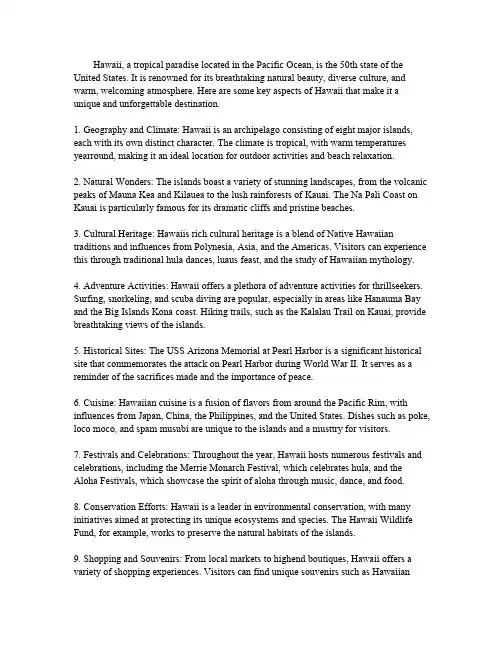
Hawaii,a tropical paradise located in the Pacific Ocean,is the50th state of the United States.It is renowned for its breathtaking natural beauty,diverse culture,and warm,welcoming atmosphere.Here are some key aspects of Hawaii that make it a unique and unforgettable destination.1.Geography and Climate:Hawaii is an archipelago consisting of eight major islands, each with its own distinct character.The climate is tropical,with warm temperatures yearround,making it an ideal location for outdoor activities and beach relaxation.2.Natural Wonders:The islands boast a variety of stunning landscapes,from the volcanic peaks of Mauna Kea and Kilauea to the lush rainforests of Kauai.The Na Pali Coast on Kauai is particularly famous for its dramatic cliffs and pristine beaches.3.Cultural Heritage:Hawaiis rich cultural heritage is a blend of Native Hawaiian traditions and influences from Polynesia,Asia,and the Americas.Visitors can experience this through traditional hula dances,luaus feast,and the study of Hawaiian mythology.4.Adventure Activities:Hawaii offers a plethora of adventure activities for thrillseekers. Surfing,snorkeling,and scuba diving are popular,especially in areas like Hanauma Bay and the Big Islands Kona coast.Hiking trails,such as the Kalalau Trail on Kauai,provide breathtaking views of the islands.5.Historical Sites:The USS Arizona Memorial at Pearl Harbor is a significant historical site that commemorates the attack on Pearl Harbor during World War II.It serves as a reminder of the sacrifices made and the importance of peace.6.Cuisine:Hawaiian cuisine is a fusion of flavors from around the Pacific Rim,with influences from Japan,China,the Philippines,and the United States.Dishes such as poke, loco moco,and spam musubi are unique to the islands and a musttry for visitors.7.Festivals and Celebrations:Throughout the year,Hawaii hosts numerous festivals and celebrations,including the Merrie Monarch Festival,which celebrates hula,and the Aloha Festivals,which showcase the spirit of aloha through music,dance,and food.8.Conservation Efforts:Hawaii is a leader in environmental conservation,with many initiatives aimed at protecting its unique ecosystems and species.The Hawaii Wildlife Fund,for example,works to preserve the natural habitats of the islands.9.Shopping and Souvenirs:From local markets to highend boutiques,Hawaii offers a variety of shopping experiences.Visitors can find unique souvenirs such as Hawaiianquilts,koa wood crafts,and locally made products.10.Resorts and Accommodations:The islands are home to a range of accommodations, from luxurious resorts to cozy bed and breakfasts.Many resorts offer activities such as yoga classes,cultural workshops,and access to private beaches.In conclusion,Hawaii is a destination that offers something for everyone,from its natural beauty and cultural experiences to its adventure activities and delicious cuisine.Whether youre seeking relaxation,adventure,or a deeper understanding of a unique culture, Hawaii is a place that will leave you with unforgettable memories.。
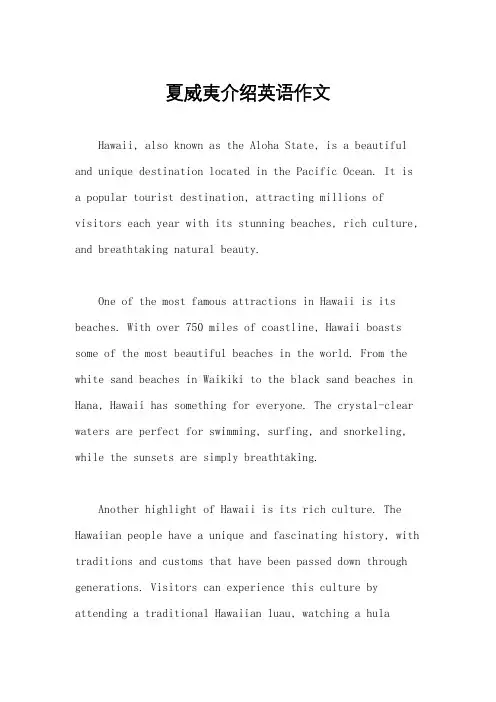
夏威夷介绍英语作文Hawaii, also known as the Aloha State, is a beautiful and unique destination located in the Pacific Ocean. It is a popular tourist destination, attracting millions of visitors each year with its stunning beaches, rich culture, and breathtaking natural beauty.One of the most famous attractions in Hawaii is its beaches. With over 750 miles of coastline, Hawaii boasts some of the most beautiful beaches in the world. From the white sand beaches in Waikiki to the black sand beaches in Hana, Hawaii has something for everyone. The crystal-clear waters are perfect for swimming, surfing, and snorkeling, while the sunsets are simply breathtaking.Another highlight of Hawaii is its rich culture. The Hawaiian people have a unique and fascinating history, with traditions and customs that have been passed down through generations. Visitors can experience this culture by attending a traditional Hawaiian luau, watching a hulaperformance, or visiting one of the many historical sites on the islands.Hawaii is also home to some of the world's most stunning natural wonders. From the towering peaks of Mauna Kea and Haleakala to the lush rainforests of Kauai,Hawaii's natural beauty is truly awe-inspiring. Visitors can explore these wonders by hiking, biking, or taking a scenic drive.In addition to its natural beauty and rich culture, Hawaii is also known for its delicious cuisine. With a blend of Asian, Polynesian, and American influences,Hawaii's cuisine is a unique and flavorful experience. Some must-try dishes include poke, kalua pork, and shave ice.Overall, Hawaii is a truly magical destination that offers something for everyone. Whether you're looking for adventure, relaxation, or a cultural experience, Hawaii has it all. So why not book your trip today and experience the beauty and wonder of the Aloha State?。
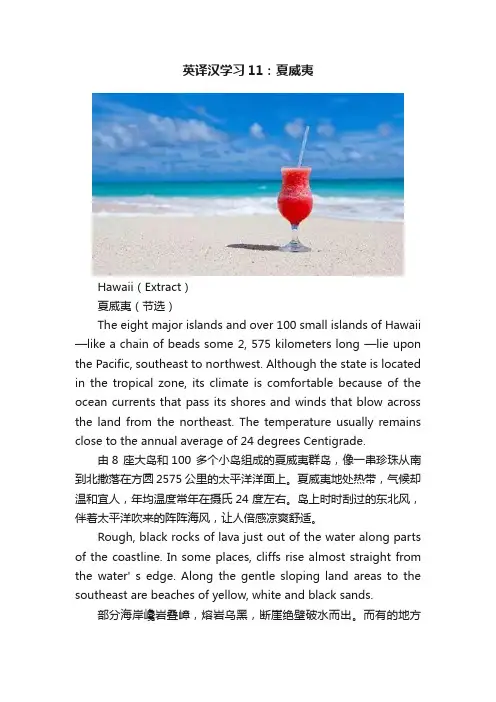
英译汉学习11:夏威夷Hawaii(Extract)夏威夷(节选)The eight major islands and over 100 small islands of Hawaii —like a chain of beads some 2, 575 kilometers long —lie upon the Pacific, southeast to northwest. Although the state is located in the tropical zone, its climate is comfortable because of the ocean currents that pass its shores and winds that blow across the land from the northeast. The temperature usually remains close to the annual average of 24 degrees Centigrade.由8 座大岛和100 多个小岛组成的夏威夷群岛,像一串珍珠从南到北撒落在方圆2575 公里的太平洋洋面上。
夏威夷地处热带,气候却温和宜人,年均温度常年在摄氏24 度左右。
岛上时时刮过的东北风,伴着太平洋吹来的阵阵海风,让人倍感凉爽舒适。
Rough, black rocks of lava just out of the water along parts of the coastline. In some places, cliffs rise almost straight from the water' s edge. Along the gentle sloping land areas to the southeast are beaches of yellow, white and black sands.部分海岸巉岩叠嶂,熔岩乌黑,断崖绝壁破水而出。

夏威夷英文介绍作文英文:Hawaii is a beautiful and unique place that I have had the pleasure of visiting. The islands are located in the middle of the Pacific Ocean and are known for their stunning beaches, clear blue waters, and lush greenery. Hawaii is also home to a vibrant culture and history, with influences from Polynesia, Asia, and the United States.One of my favorite things about Hawaii is the food. I love trying new dishes, and Hawaii has plenty of unique and delicious options. For example, I tried poke for the first time in Hawaii, which is a type of raw fish salad. It was so fresh and flavorful!Another thing that I enjoyed during my trip was the outdoor activities. Hawaii is a great place to hike, surf, and snorkel. I went on a hike to Manoa Falls, which was absolutely breathtaking. The scenery was so beautiful andit was a great workout too!Overall, I highly recommend visiting Hawaii. It trulyis a paradise on earth.中文:夏威夷是一个美丽而独特的地方,我有幸去过。
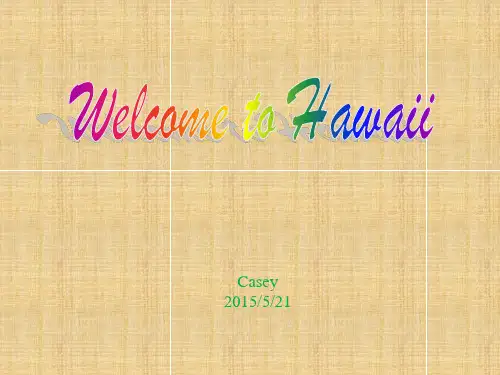
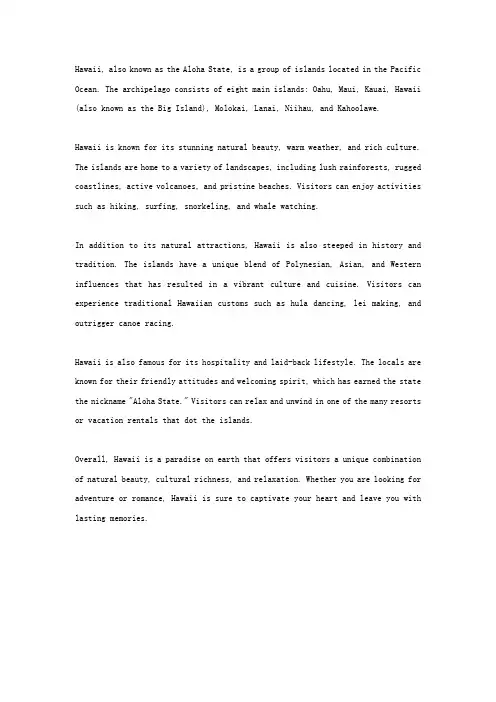
Hawaii, also known as the Aloha State, is a group of islands located in the Pacific Ocean. The archipelago consists of eight main islands: Oahu, Maui, Kauai, Hawaii (also known as the Big Island), Molokai, Lanai, Niihau, and Kahoolawe.Hawaii is known for its stunning natural beauty, warm weather, and rich culture. The islands are home to a variety of landscapes, including lush rainforests, rugged coastlines, active volcanoes, and pristine beaches. Visitors can enjoy activities such as hiking, surfing, snorkeling, and whale watching.In addition to its natural attractions, Hawaii is also steeped in history and tradition. The islands have a unique blend of Polynesian, Asian, and Western influences that has resulted in a vibrant culture and cuisine. Visitors can experience traditional Hawaiian customs such as hula dancing, lei making, and outrigger canoe racing.Hawaii is also famous for its hospitality and laid-back lifestyle. The locals are known for their friendly attitudes and welcoming spirit, which has earned the state the nickname "Aloha State." Visitors can relax and unwind in one of the many resorts or vacation rentals that dot the islands.Overall, Hawaii is a paradise on earth that offers visitors a unique combination of natural beauty, cultural richness, and relaxation. Whether you are looking for adventure or romance, Hawaii is sure to captivate your heart and leave you with lasting memories.。
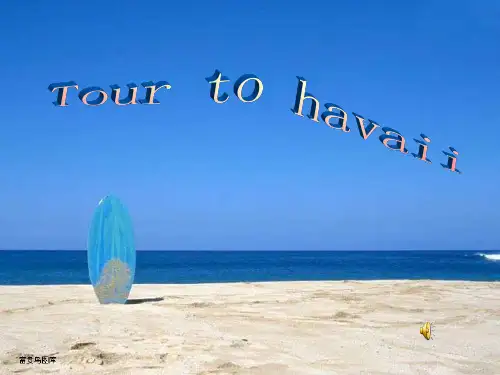
美国夏威夷英文介绍Hawaii 夏威夷风情For most of us, Hawaii begins to weave her spell with some little glimmer of awareness. Golden beaches and golden people. Sun, sand, sea, and surf ... And somewhere between the blue skies and the palm trees ... we're hooked.对于大部分人来说,那些星星点点的关于夏威夷的印象,足以让我们沉浸于她的魅力。
金色的海滩,金色的人们。
阳光、沙子、大海、浪花……在蓝天和棕榈树之间,我们流连忘返。
The Hawaiian Islands are one of the most beautiful places on earth. The weather is friendly. The temperature ranges from 60-90 degrees all year long. It's a little warmer in summer, and a little cooler in winter, but every day is a beach day for somebody.夏威夷岛是世界上最美丽的地方之一。
这里天气宜人,气温整年在华氏60-90度之间变化。
夏天稍暖,冬天稍凉,但对于某些人来说每天都是晒太阳的好日子。
夏威夷英文介绍There are no strangers in Paradise. Perhaps the most beautiful part of Hawaii is the genuine warmth of people. We call it the spirit of Aloha. It has allowed a melting pot of cultures from all over the world to find common ground, and a new home, in this most gentle of places.在这人间天堂没有陌生人。
夏威夷的具体介绍作文英文英文:Hawaii, also known as the Aloha State, is a group of islands located in the Pacific Ocean. It is one of the most popular tourist destinations in the world due to its stunning beaches, tropical climate, and unique culture. I have had the pleasure of visiting Hawaii twice and each time I have fallen more in love with this beautiful place.One of the things that makes Hawaii so special is its diverse landscape. Each island has its own unique features and attractions. For example, the island of Oahu is home to the bustling city of Honolulu and the world-famous Waikiki Beach. Maui is known for its stunning beaches and breathtaking sunsets, while Kauai is known for its lush greenery and stunning waterfalls.Another thing that makes Hawaii so special is its culture. The Hawaiian people have a deep respect for theirland and their ancestors. This is evident in their traditional dances, music, and art. One of the most popular cultural events in Hawaii is the annual Merrie Monarch Festival, which celebrates hula dancing and Hawaiian culture.But perhaps the most appealing aspect of Hawaii is its laid-back and friendly atmosphere. The locals, known as "kama'aina," are welcoming and always happy to share their knowledge of the islands. Whether you are looking for a quiet beach to relax on or an adventurous hike through the rainforest, there is something for everyone in Hawaii.中文:夏威夷,也被称为阿罗哈州,是位于太平洋中的一组岛屿。
夏威夷岛屿介绍夏威夷(英语:Hawaii,是美国唯一以3个元音结尾的州)在1959年8月21日成为美国的第50个州,由夏威夷群岛所组成,位于北太平洋中,距离美国本土3,700公里,总面积16,633平方公里,属于太平洋沿岸地区。
小马过河国际教育全国免费电话咨询:4008-123-267!留学交流群:108088544。
2000年夏威夷州的常住人口为1,211,537人。
约五世纪时,夏威夷原住民玻利尼西亚人从南太平洋移居到此。
是太平洋上,海空交通要地,战略位置十分重要。
夏威夷(Hawaii)是夏威夷群岛中最大的岛屿,又称大岛,位于岛链最南端,有丰富的火山活动,设有火山国家公园,华人又称火山岛。
全岛属夏威夷县范围。
主要都市有东侧的希洛(Hilo)与西侧的科纳市(Kona)。
首府为火奴鲁鲁(檀香山)。
在1778至1898年间,夏威夷也被称为“三明治群岛”(Sandwich Islands)。
夏威夷州是距今最近加入美国的州份,与美国其他各州有着明显的区别:它除了是美国最南方的州外,也是美国唯一一个全部位于热带的州;它与阿拉斯加州是美国各州中,仅有的两个不与其他各州相连的州份,也是美国唯一一个没有任何土地位在美洲大陆的州。
论美国所有领土而言,夏威夷州是除了美国海外属地和群岛以外,最南端的一州,但非最南端的领土(美国最南端的领土落在美属萨摩亚群岛)。
在族群分布上,它是两个非白种人居多数州份的其中之一,是美国唯一白种人不过半数的州。
白种人约占三分之一,其余为日本人、玻利尼西亚人、菲律宾人、中国人、朝鲜人。
比起其他各州,夏威夷州拥有最大的亚裔人口比例。
生态及农业方面,它是全世界拥有最多濒临绝种物种的地方,也是美国唯一生产咖啡具有工业规模的州份。
岛屿介绍瓦胡岛(欧胡岛):欧胡岛可能是夏威夷群岛中最多彩多姿的岛屿,它具备多种文化的特质,瑰丽而多样化的景观及丰富的户外活动。
岛上有全夏威夷最主要的檀香山国际机场(百分之八十的旅客飞到檀香山当作他们夏威夷之旅的第一站),及迷人的檀香山(Honolulu)与威基基(Waikiki)海滩。
夏威夷群岛位于北太平洋,由8个大岛和120多个小岛组成。
夏威夷群岛没有非常有名气的名胜古迹,但却用她得天独厚的自然风光和岛上居民的热情,招呼着每年来自全球成千上万的游客。
夏威夷群岛的八个主岛:夏威夷岛、毛伊岛、卡胡拉韦岛、拉奈岛、莫洛凯岛、瓦胡岛、可爱岛、尼豪岛全都是火山岛,其中瓦胡岛是夏威夷州州府檀香山所在;可爱岛静谧安详,极具田园风光;毛伊岛的秀丽山谷、夏威夷大岛的火山熔岩同样不可错过。
夏威夷的波利尼西亚文化创造出许多独特的文化表演,其中,草裙舞是游客印象最深刻的。
夏威夷融合东西方之文化,连结南北半球文明,是名副其实的闪耀在太平洋上的一颗明珠
Hawaii is the most recent of the 50 U.S. states (joined the Union on August 21, 1959), and is the only U.S. state made up entirely of islands. It is the northernmost island group in Polynesia, occupying most of an archipelago in the central Pacific Ocean.
Hawaii’s diverse natural scenery, warm tropical climate, abundance of public beaches, oceanic surroundings, and active volcanoes make it a popular destination for tourists, surfers, biologists, and volcanologists alike. Due to its mid-Pacific location, Hawaii has many North American and Asian influences along with its own vibrant native culture. Hawaii has over a million permanent residents along with many visitors and U.S. military personnel. The state encompasses nearly the entire volcanic Hawaiian Island chain, which comprises hundreds of islands spread over 1,500 miles (2,400 km). Hawaii is the 8th-least extensive, the 11th-least populous, but the 13th-most densely populated of the 50 U.S. states. Hawaii's ocean coastline is approximately 750 miles (1,210 km) long, which is fourth in the United States after those
of Alaska, Florida and California.
Hawaii is one of two states that do not observe daylight saving time, the other being Arizona. It is also one of two states that are not in theContiguous United States; the other is Alaska. Hawaii is the only state with an Asian plurality.。